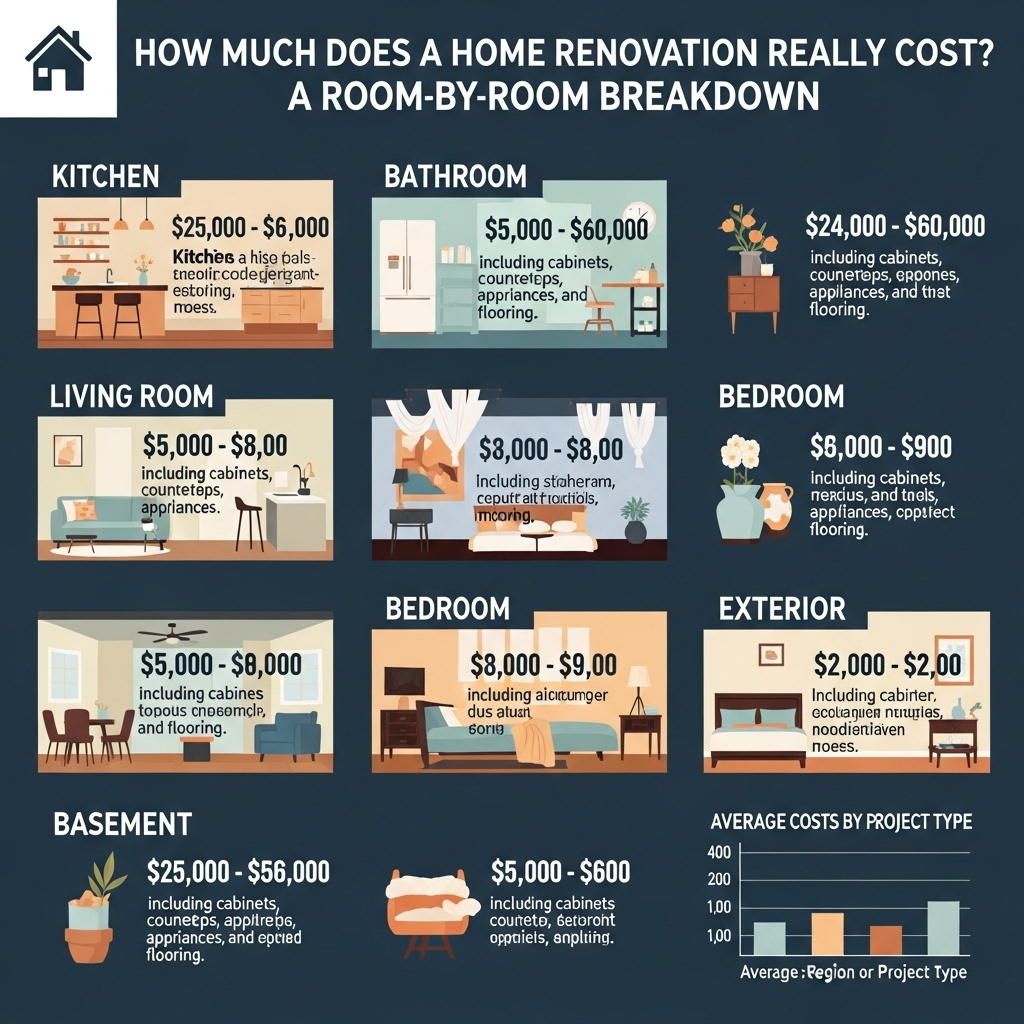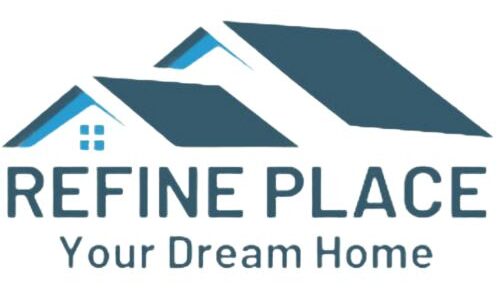Ever stared at your outdated kitchen or cramped bathroom and wondered, “How much would it really cost to transform this space?” You’re not alone. Homeowners across America are investing record-breaking amounts in renovations, with over $600 billion spent nationwide in 2024 alone according to a 2025 report from the Joint Center for Housing Studies at Harvard University.
As an interior designer who’s helped hundreds of clients navigate the renovation process, I know that the biggest hurdle isn’t inspiration—it’s understanding the true cost. This guide breaks down exactly what you’ll pay for each room, why prices vary so dramatically, and how to stretch your budget without sacrificing quality. Whether you’re planning a minor refresh or a complete overhaul, having realistic expectations will help you avoid budget nightmares and achieve the home of your dreams.

Understanding Home Renovation Costs
When planning a renovation, many homeowners are shocked by the actual price tag. The average home renovation costs about $22,000, though this can vary significantly based on project scope, location, and materials [amerisave.com]. For more comprehensive projects involving multiple rooms, the average jumps to $52,000 with a typical range between $19,000 and $88,000 [angi.com].
The most important metric to understand is cost per square foot, which typically falls between $15 and $150 depending on your location and the quality of materials you select [thisoldhouse.com]. This wide range reflects how dramatically your choices impact the bottom line. A basic bathroom refresh with standard fixtures might cost $15-$25 per square foot, while a luxury kitchen with custom cabinetry and high-end appliances could reach $150 per square foot or more.
“When drafting your home design, think about the function of each room and the flow of your home as a whole. Thoughtful planning at this stage will help you create an effective and comfortable space that your household can enjoy for years to come.” [angi.com]
Pro Tip: Before finalizing your renovation plan, create a detailed wish list and categorize items as “must-haves,” “nice-to-haves,” and “dream items.” This prioritization helps you make informed trade-offs when budget constraints arise.
Room-by-Room Cost Breakdown
Kitchen Renovation Costs
The kitchen remains the most valuable room to renovate, offering the highest return on investment. Basic kitchen renovations start around $14,550 for simple updates like new paint and hardware, while mid-range projects average $25,000 for quality cabinets, countertops, and appliances. High-end kitchen remodels can easily exceed $40,400 when incorporating custom cabinetry, luxury appliances, and structural changes [thisoldhouse.com].
| Kitchen Renovation Level | Cost Range | Key Features |
|---|---|---|
| Basic Update | $14,550-$20,000 | New paint, hardware, minor cabinet refacing |
| Mid-Range | $20,000-$35,000 | Quality cabinets, new countertops, mid-tier appliances |
| High-End | $35,000-$80,000+ | Custom cabinetry, luxury appliances, layout changes |
When planning your kitchen budget, allocate 30-40% for cabinetry, 20-25% for appliances, 15-20% for countertops, and 10-15% for plumbing and electrical work. Remember that moving walls or changing the layout will significantly increase costs due to structural work and reconfiguring mechanical systems.
Bathroom Renovation Costs
Bathrooms deliver the second-highest ROI of any home renovation. A basic bathroom update costs $6,600-$12,000 for new fixtures and finishes, while a mid-range renovation runs $12,000-$18,000 for quality materials and custom tile work. Luxury bathroom renovations exceed $28,000 when including freestanding tubs, heated floors, and high-end finishes [thisoldhouse.com].
| Bathroom Renovation Level | Cost Range | Key Features |
|---|---|---|
| Basic Update | $6,600-$12,000 | New fixtures, paint, basic tile |
| Mid-Range | $12,000-$18,000 | Custom tile, quality fixtures, improved storage |
| High-End | $18,000-$28,000+ | Freestanding tubs, heated floors, premium finishes |
Pro Tip: Focus on timeless design elements rather than trendy features that may date quickly. A classic subway tile or neutral color palette ensures your bathroom remains stylish for years without requiring another costly renovation.
Living Room & Bedroom Renovation Costs
Living rooms and bedrooms generally cost less per square foot than kitchens and bathrooms since they don’t require plumbing or complex mechanical systems. Basic updates for these spaces average $20-$40 per square foot, while comprehensive renovations with structural changes can reach $100+ per square foot [renoworks.com].
| Room Type | Cost Range | Notes |
|---|---|---|
| Living Room | $10,000-$35,000 | Includes flooring, built-ins, lighting, and finishing |
| Bedroom | $8,000-$25,000 | Includes closet systems, flooring, and finishing |
| Whole House (2,000 sq ft) | $30,000-$150,000 | Varies dramatically based on scope |
When renovating living spaces, consider how the flow between rooms impacts your daily life. As noted in the [angi.com] guide, “thoughtful planning at this stage will help you create an effective and comfortable space.” Adding built-in storage or reconfiguring layouts to improve traffic flow can dramatically enhance your home’s functionality without breaking the bank.
Basement & Outdoor Renovation Costs
Finished basements add valuable living space at a lower cost per square foot than above-grade renovations, typically $30-$70 per square foot. Outdoor projects vary widely: deck installations cost $20-$60 per square foot, while complete outdoor living spaces with kitchens and fireplaces can exceed $100 per square foot [thisoldhouse.com].
| Outdoor/Additional Space | Cost Range | Key Considerations |
|---|---|---|
| Basement Finish | $25,000-$70,000 | Requires proper moisture control and egress |
| Deck Installation | $15,000-$35,000 | Material choice (wood vs. composite) significantly impacts cost |
| Outdoor Kitchen | $10,000-$50,000 | Plumbing, gas lines, and weather-resistant materials increase costs |
Pro Tip: Basements require careful waterproofing and proper ventilation to avoid moisture issues. Budget 15-20% of your basement renovation costs for these critical infrastructure elements.
Factors That Impact Your Renovation Budget
Location and Labor Costs
Where you live dramatically impacts renovation costs. Homeowners in coastal metropolitan areas like New York, San Francisco, and Los Angeles pay 20-30% more than those in Midwest or Southern regions for comparable projects. Labor costs account for 40-50% of most renovation budgets, so understanding your local market is crucial [amerisave.com].
Material Selection
The difference between basic and premium materials can double or triple your costs. For example, quartz countertops range from $50-$150 per square foot, while natural stone like marble can exceed $200 per square foot. Similarly, basic ceramic tile costs $1-$5 per square foot, while luxury porcelain tile runs $8-$15 per square foot [thisoldhouse.com].
Project Complexity
Simple cosmetic updates cost far less than structural changes. Moving walls, relocating plumbing, or adding windows requires additional engineering, permits, and skilled labor. Every major change to your home’s structure adds 15-30% to your overall budget [renoworks.com].
Permits and Fees
Don’t overlook the hidden costs of permits and fees, which typically add 5-15% to your renovation budget. These vary significantly by location but generally include building permits, inspection fees, and sometimes impact fees for infrastructure improvements [angi.com].
How to Budget Smartly for Your Renovation
Create a Detailed Scope of Work
Begin with a comprehensive plan that outlines every element of your renovation. The more specific your scope, the more accurate your quotes will be. A vague request like “renovate the kitchen” could mean anything from $15,000 to $80,000 depending on what’s included.
Get Multiple Quotes
Always obtain at least three detailed quotes from reputable contractors. Make sure each quote includes the same scope of work to ensure accurate comparisons. Be wary of bids that seem too low—they often come with hidden costs or poor quality [renoworks.com].
Include Contingency Funds
Smart renovators always budget for the unexpected. Allocate 10-20% of your total budget for contingencies to cover surprises like hidden structural damage, plumbing issues, or material shortages. This prevents your project from grinding to a halt when inevitable problems arise.
Phase Your Project
If your budget is tight, consider phasing your renovation over time. Complete high-ROI projects first (like kitchens and bathrooms), then tackle other areas as funds become available. This approach maintains your home’s functionality during construction and spreads out financial pressure.
Pro Tips to Maximize Your Renovation ROI
Prioritize High-Value Projects
Kitchen and bathroom renovations consistently deliver the highest return on investment. A minor kitchen remodel recoups 78.3% of costs at resale, while bathroom renovations return 67.2% [thisoldhouse.com]. Focus your budget on these areas first if resale value is a priority.
Use Visual Planning Tools
Leverage digital tools to visualize your renovation before committing to expensive decisions. As suggested by [renoworks.com], “Use Renoworks’ Visualizer Tool to design your remodel, compare product options, and get a tailored renovation quote.” This helps avoid costly changes during construction.
Balance Custom and Stock Elements
Incorporate a mix of custom and stock elements to optimize your budget. Custom cabinetry adds value but can be balanced with stock plumbing fixtures or standard lighting to control costs. Aim for 70% standard components and 30% custom details for the best value.
Negotiate Smartly
When negotiating with contractors, focus on value rather than just price. A slightly higher bid that includes better materials or a longer warranty may save money long-term. Ask about payment schedules—avoid contractors requiring more than 30% upfront.
Conclusion: Renovate with Confidence
Understanding home renovation costs doesn’t have to feel overwhelming. With average costs ranging from $19,500 to $88,400 for most homeowners [thisoldhouse.com], having a realistic budget framework sets you up for success. Remember that the true cost depends on your specific goals, location, and material choices—there’s no one-size-fits-all answer.
Start by defining your must-haves versus nice-to-haves, then research costs specific to your area. Obtain detailed quotes from multiple contractors and include a healthy contingency for unexpected expenses. Most importantly, invest in thoughtful design that enhances your home’s functionality and flow—this creates lasting value beyond mere aesthetics.
Whether you’re updating a single room or embarking on a whole-house renovation, proper planning transforms what could be a stressful experience into an exciting journey toward your dream home. With the right budget framework and professional guidance, you’ll enjoy the process and the results for years to come.
“If you’re planning a home renovation, one of the biggest hurdles is getting a handle on the cost. Remodeling isn’t cheap—and between materials, fixtures, permits, and labor, it’s easy to lose track of where your money’s going.” [renoworks.com]
Ready to start your renovation journey? Use a 3D visualizer tool to design your space and get a tailored quote before committing to your project. This simple step can save thousands in unexpected costs and ensure you love your results. Start Your Project Today →
